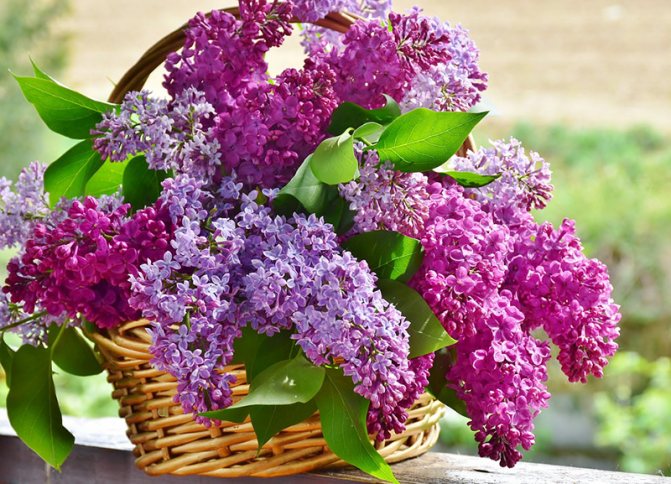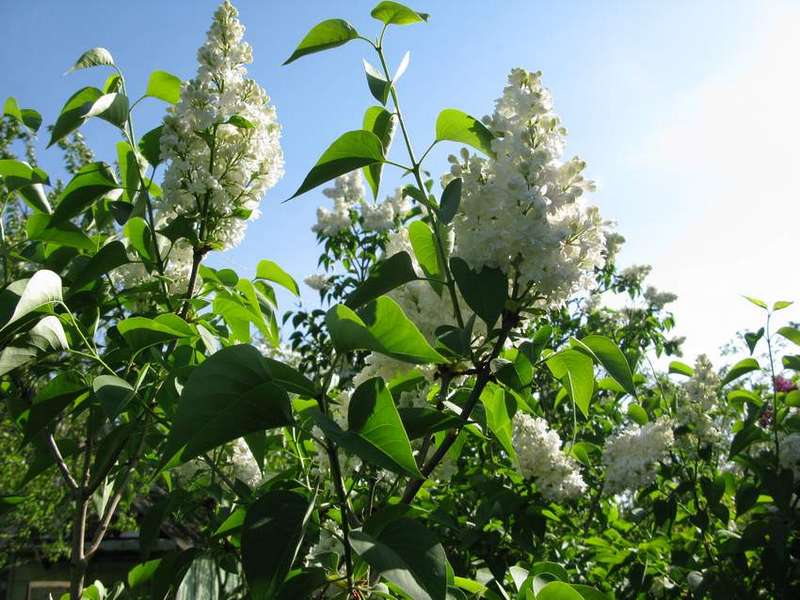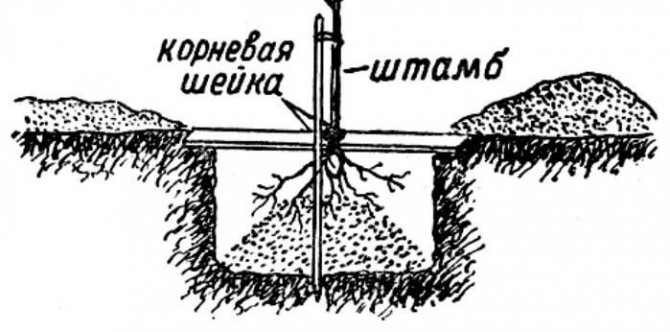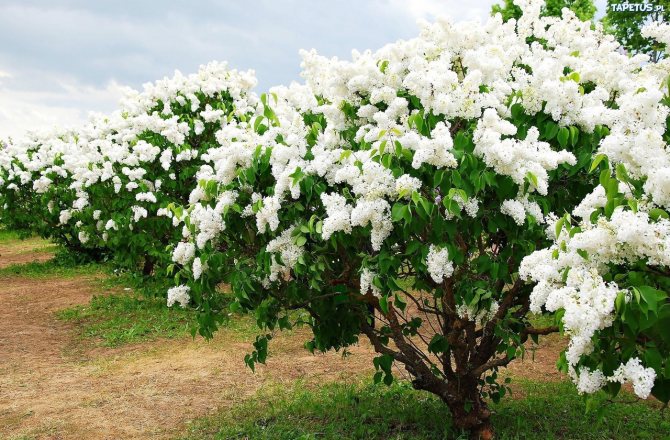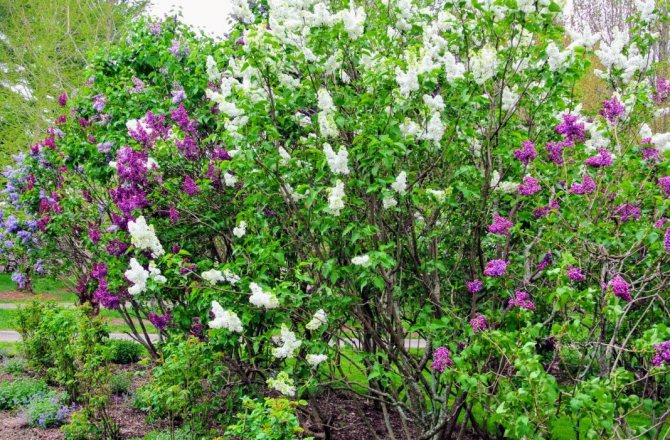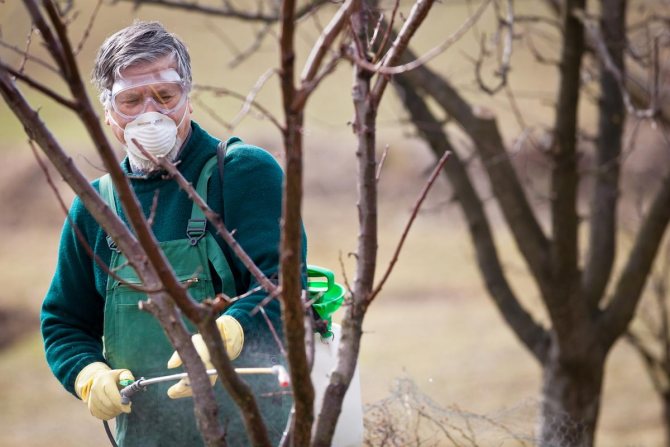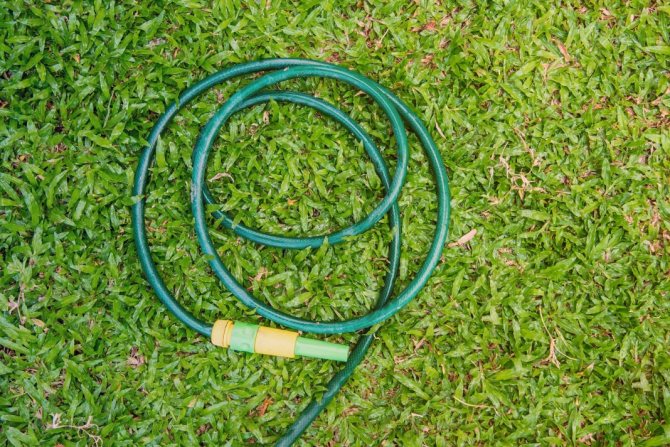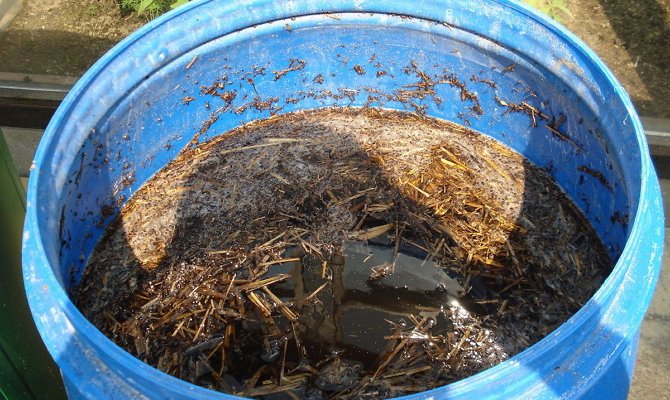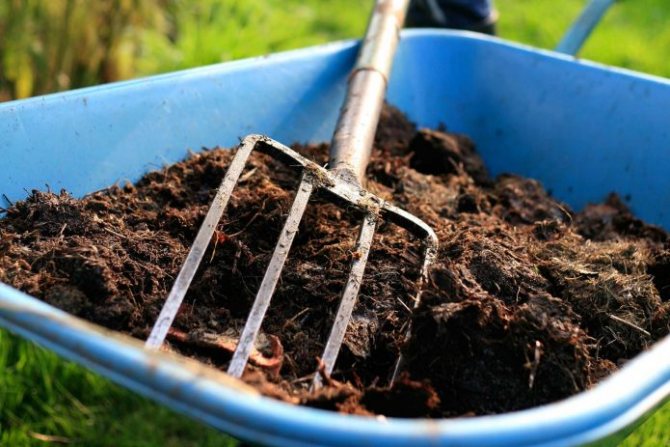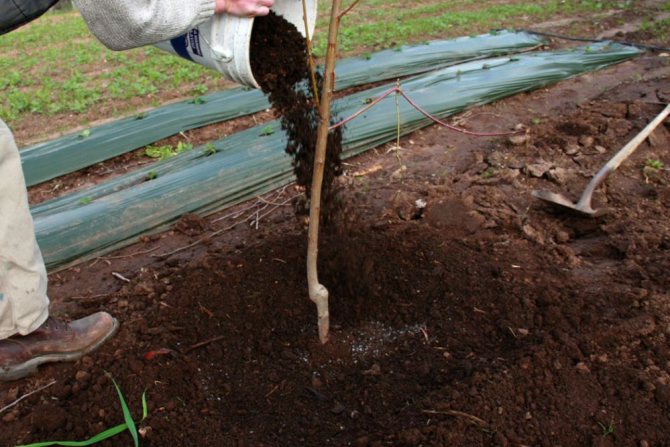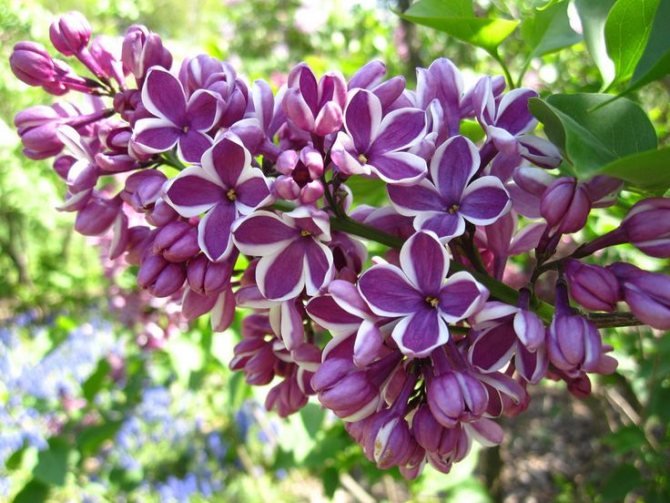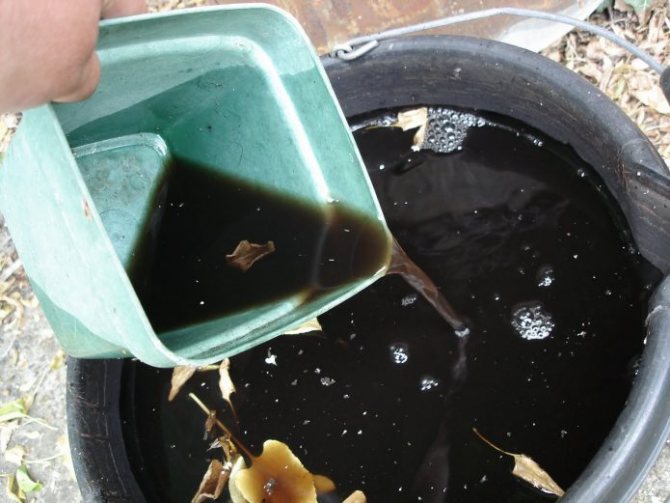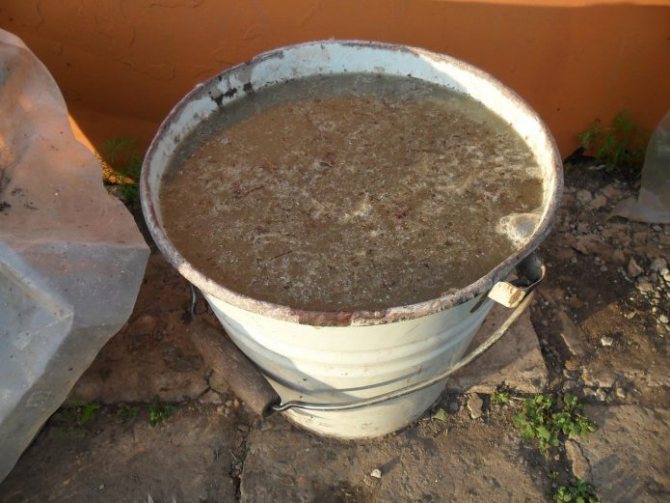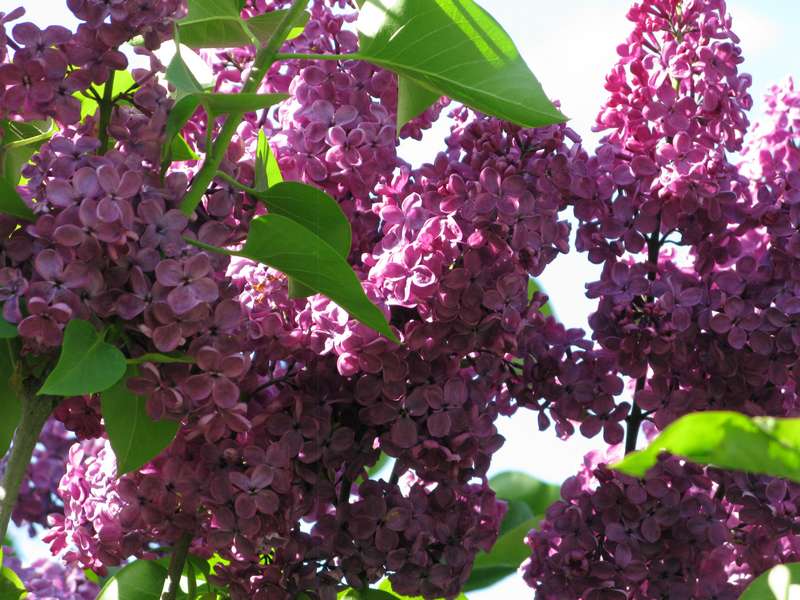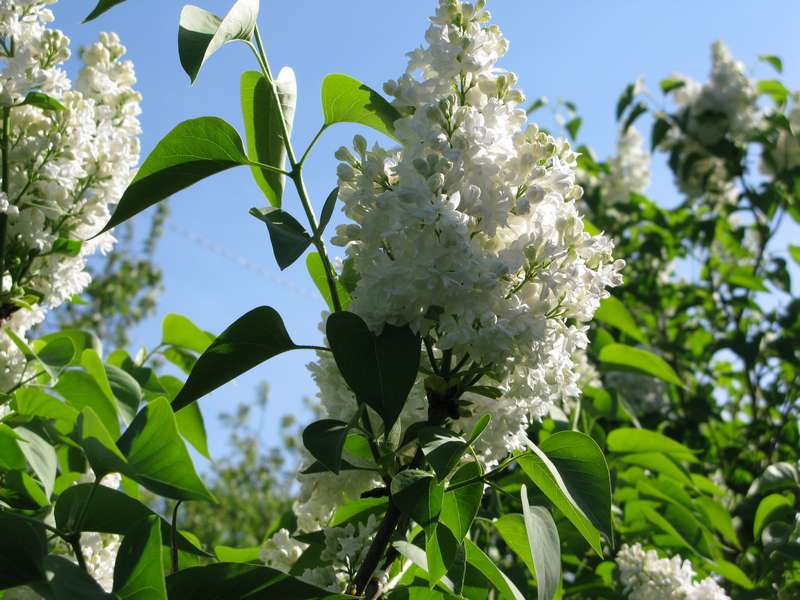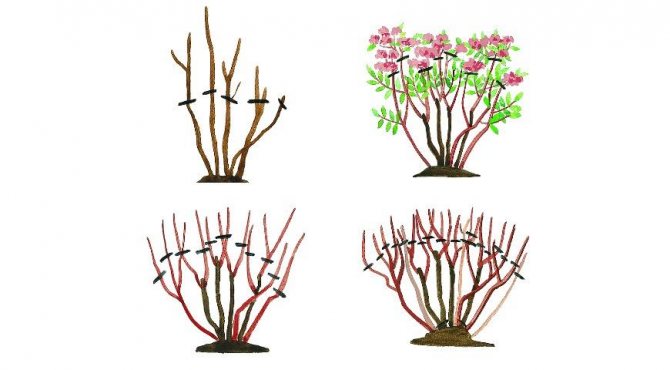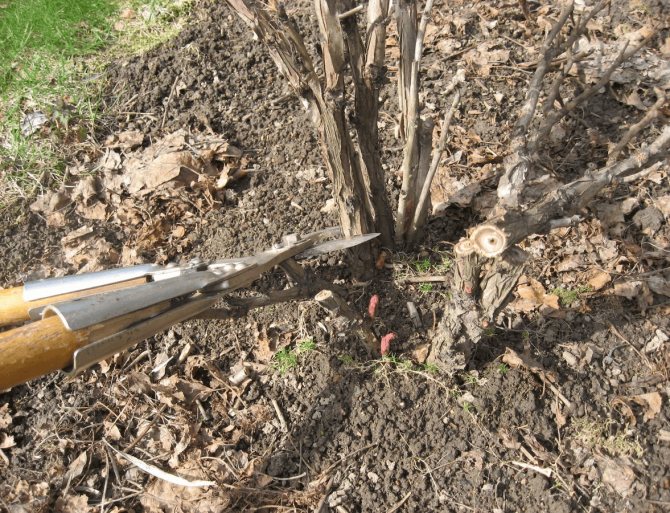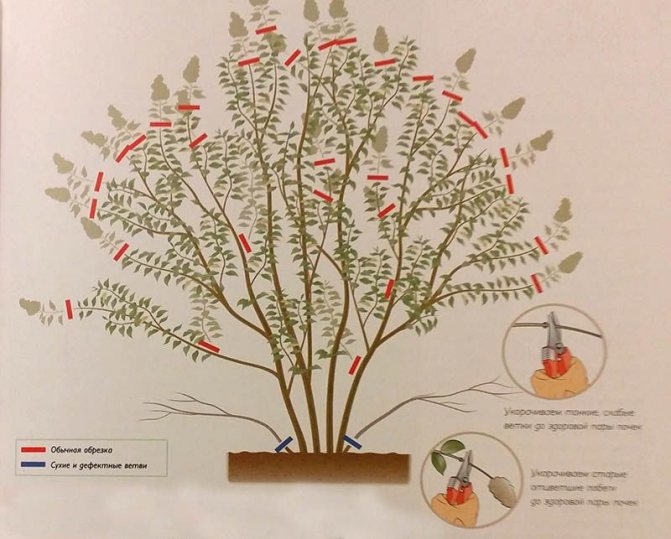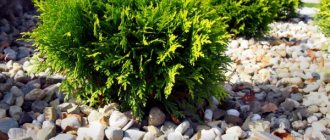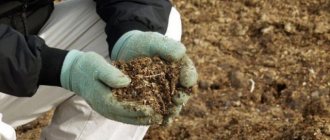This beautiful ornamental shrub pleases with its lush flowering and sweet aroma. Depending on the type of lilac, its variety and design concept, the plant is used both for single planting, and in small groups or as a hedge.
In this article we will tell you about the intricacies of planting and caring for lilacs so that for many more years it will delight you with its flowering.
Where to plant lilacs
First of all, you need to choose the right place for landing. Lilac belongs to unpretentious crops, but it does not tolerate excess moisture well. In such conditions, the roots begin to rot, and even an adult shrub can die. That is why it is not recommended to plant in swampy lowlands or in areas that are regularly flooded with water. In addition, it is undesirable to plant shrubs in the shade of large trees or close to buildings. Such a neighborhood will not only create an unwanted shadow, but also increase the moisture content of the soil.
It is also recommended to choose areas with slightly acidic or neutral soils. They contain a sufficient amount of humus for the development of seedlings. When choosing a place for landing, be guided not only by the quality of the soil and its moisture content, but also by the illumination of the site. Lilac loves sunlight, but at the same time it does not tolerate drafts, so it should be planted in sunny places, protected from strong winds.
How to choose planting material
The choice of the seedling itself plays an equally important role. When buying, you should pay attention to the root system: it should be strong and branched, and its diameter should be about 30 cm.
Note: It is better to buy planting material in specialized stores, and not from hands. So you can be sure of the quality and health of the seedlings.
At the time of purchase, you can carry out a small test of the viability of the plant. You need to choose a thin small root and bend it. If it breaks and darkens, then the root is dry, and such a bush will not take root.

Figure 1. Examples of quality planting material with a closed root system
You can also check the quality of the seedling by the condition of its bark. If you lightly scratch it with your finger, you should leave a green mark. A brown or gray surface indicates that the seedling is sick and should not be bought.
Healthy and strong trees reach a height of half a meter or more, and also have from 3 to 6 skeletal branches (Figure 1).
Landing
To achieve a blooming lilac garden (syringaria), it is best to use ready-made seedlings for planting.
The most suitable for lilac would be open and sunny place... In conditions of shade or even partial shade, the plant grows slower, blooms less abundantly, loses its shape - the foliage is less dense, the shoots are stretched out.
The planting should not be thickened. Strongly branched and tall varieties are best planted singly. Smaller ones feel good in alley and group plantings of 3-5 bushes.
- In a single planting, the distance between plants should be not less than 2.5-3 m.
- In alleys and group - not less than 1.5 m.
- For hedges - can be reduced up to 1 m... Please note that with a dense planting, flowering will not be plentiful.
Try to choose a place protected from strong winds, especially for less winter-hardy varieties.
Also refrain from lowlands, in which melt water accumulates in spring, rainwater in autumn, and wetlands. This is due to the fact that the roots of lilacs can rot and die off due to stagnant water.
The best option would be a small elevation with good drainage and low groundwater occurrence - no closer than 1.5 m to the water surface. Try to place lilacs on gentle southern or southeastern slopes.
The plant can also be planted on a flat area without hills. In this case, take care of a good drainage system.
Shaggy lilac
When to plant lilacs
Many people mistakenly believe that the best time to plant any garden crops, including lilacs, is spring. In fact, this ornamental shrub is best planted in the ground in late summer or early autumn. In such conditions, the tree will have time to take root and get stronger before the onset of cold weather.
But, if you bought a seedling with an open root system in the spring, and the buds have not yet blossomed on it, planting can be carried out at this time. The main thing is to prevent the awakening of the buds, since planting during such a period can greatly weaken the shrub and even lead to its death.
Also, planting can be carried out in mid-July, when the shrub has already bloomed and is preparing for a dormant period. But the best time is September, and it is advisable to carry out the procedure before the middle of the month, when the daytime temperature is high enough and there is no danger of night frosts.
Description of the bush
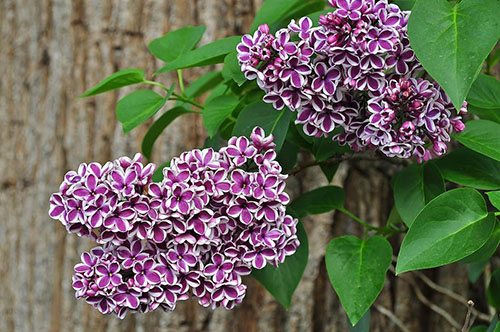

Lilacs have whole, opposite leaves that fall off in the winter. The flowers are pink, purple or white. They are located in panicles ending in branches. A small bell-shaped calyx with 4 teeth. The corolla is cylindrical and has a four-part bend. The lilac has two stamens that are well attached to the tube. One ovary with a double stigma.


Today, one of the common types of lilacs that are used for planting is common lilac. Such a shrub has a luxurious look, enchants not only with beautiful flowers, but also with a pleasant smell. Lilacs are easy to plant, unpretentious to care for, and take root well in the open field.
Today, more than 10 varieties of lilac are known.
Planting in autumn
In autumn, it is advisable to complete planting by mid-September, so that the seedlings have time to take root before the onset of cold weather. During this period, it is still warm enough and there is no night frost, so the risk of freezing of young plants is practically minimal.
Figure 2. Stages of autumn shrub planting
The landing technology includes several stages. First, you need to clear the area of weeds and roots of other plants. Secondly, it is necessary to prepare pits with vertical walls up to 50 cm deep.
Note: If you plan to plant several bushes, it is better to place them at a distance of 2-3 meters from each other so that the roots can develop normally.
A drainage layer is laid at the bottom of the pit and filled with fertile soil consisting of compost or rotted manure (about 20 kg) per plant, 20 grams of superphosphate and a glass of wood ash. The resulting mixture must be poured with a mound, in the center of which a seedling is placed and its roots are straightened. It is necessary to deepen the plant into the soil in such a way that its root collar is a few centimeters above the surface. Next, you need to water the soil well, and when the water is absorbed, mulch with any organic material (Figure 2).
Transfer
Many gardeners strongly recommend replanting lilacs 1-2 years after planting. This is due to the peculiarity of lilacs to quickly consume all nutrients in the soil.In this regard, after 2 years, the soil is no longer able to provide the lilac with all the necessary substances, despite systematic feeding.
Transplanting 3-year-old lilacs is not recommended earlier than August. Young plants should be transplanted at the end of flowering at the end of spring, otherwise they will not have time to take root well before the first frost. The transplant pit should be the same size as the planting pit.
Before replanting, it is necessary to remove all injured and damaged branches. After that, dig in the shrub along the perimeter of the crown and pull it out of the soil along with the ground. Then move the tree to a new planting site, and cover it with a sufficient amount of fertile soil.
Planting in the spring in the ground
Spring is considered not the best time for this procedure, since during this period it is easy to miss the right moment for disembarkation. It is important that the buds on the seedling do not wake up before planting, but if this has already happened, the procedure is postponed until the end of summer.
Note: It is because of the chance to miss the right time for planting that it is recommended to buy seedlings with a closed root system, since they can be successfully stored for several months.
Regardless of the period, you need to properly prepare the soil: free the area from weeds, dig it up and prepare a nutritious substrate from humus, superphosphate and wood ash.
It is also necessary to inspect the seedlings themselves and remove all damaged and dry parts of the roots. In addition, it is advisable to place the roots in a solution of a root-forming preparation for several hours in order to stimulate the acclimatization of the plant in a new place.
Where to buy lilac seedlings
You can buy lilac seedlings in our online store of seedlings. We offer high-quality and healthy seedlings of both lilacs and other ornamental, fruit crops and shrubs. You can buy berry bushes from us at attractive prices with mail delivery throughout the country.
We love our customers and offer each customer a nice gift as a bonus. We give a free consultation on the correct planting, growing and caring for the purchased crop.
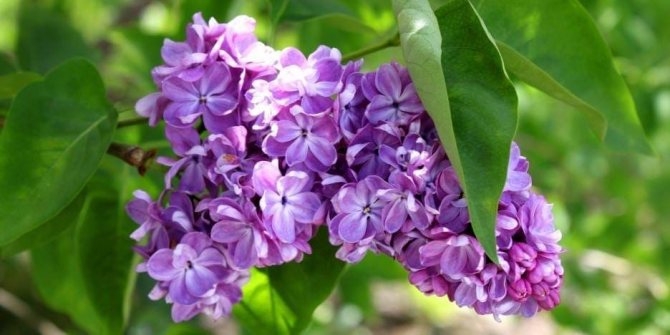

Lilac planting scheme
It is best to choose a cloudy day or evening for planting seedlings. After preparing the planting material, they proceed directly to garden work.
The classic scheme for planting lilacs looks like this:
- Dig a hole 50 * 50 cm in size.
- The nutrient soil from the hole is mixed with compost or humus, superphosphate and wood ash. In total, you will need about 20 kg of organic matter, 20 grams of mineral fertilizer and 300 grams of ash per plant. But, if the soil on the site is acidic, the amount of ash must be doubled.
- A layer of broken brick is laid at the bottom of the hole, which will act as a drain. A nutritious substrate is poured from above, forming a small mound from it.
- A prepared seedling is placed on the mound, its root system is straightened and deepened into the soil so that the root collar protrudes 3-4 cm above the soil surface.
- The pit is covered with soil mixture, lightly tamped and watered abundantly.
It is necessary to wait until the water is completely absorbed into the soil and mulch the garden. This will maintain optimal soil moisture and prevent weeds from growing, which significantly slow down the growth of young shrubs.
See the video for step-by-step planting instructions.
Distance between lilacs when landing
This ornamental shrub provides plenty of room for imagination when decorating a garden. It can be planted both singly and in groups, but if you want to form strong and beautiful shrubs, it is better to stick to a distance of 2-3 meters between individual seedlings (Figure 3).


Figure 3. Distance between lilac bushes when planting
In some cases, hedges are even created from lilacs, but in this case the plants will need more careful feeding. If you have the opportunity to maintain the optimal distance between the plants, you will not have to fertilize the lilac especially actively, since it will receive all the necessary nutrients from the soil.
How to care for lilacs
Caring for lilacs is no different from caring for most winter-hardy ornamental shrubs. Lilac tolerates cold weather, so it does not have to be insulated for the winter. Only in young grafted plants in the year of planting can the trunks be mulched with a thick layer of fallen leaves.
After planting, the plant is watered abundantly until it starts to grow. Watering lilacs is needed only when necessary - in the heat. Autumn water-charging irrigation for lilacs is not carried out.
In the early years, while the lilac does not bloom, fertilizers are not applied under it. Plants have enough organic matter added to the planting pits. Young bushes need loosening of the soil, weeding and watering.


The lilac bush begins to bloom in the third year. Then you can start the annual feeding. Mineral fertilizers will make the brushes larger, brighter and more aromatic, and increase their number.
In the spring, before flowering, you need to have time to loosen the soil in the near-trunk circle at least once and feed the plant with any complex mineral fertilizer, soluble in water. The roots of the lilac are superficial, so you need to loosen the soil carefully and shallowly.
Bouquet landing
This method of placing shrubs is rarely practiced. The fact is that with a bouquet planting, the seedlings are located very close to each other, sometimes in the same hole. This allows you to create lush plantings, but it will be difficult to care for mature bushes, especially for novice gardeners.


Figure 4. Bouquet placement of shrubs
In addition, when bouquet placement, it is necessary to take into account the characteristics of the varieties. As a rule, low-growing varieties are used for this purpose (Figure 4). Tall ones cannot be planted in this way, especially in combination with undersized species.
Description of lilac
Lilac is a genus of shrubs that belong to the Olive family. The genus consists of about 10 species, which are distributed wild in Southeast Europe and Asia, mainly in China.
Lilac leaves are opposite, usually whole, falling for the winter. The flowers are white, pink or purple, located in panicles at the ends of the branches. The fruit is a dry bivalve capsule.
The height of the lilac ranges from 2 to 8 m, the diameter of the trunks is 20 cm. Young trunks are covered with smooth bark, old ones with cracks.
The foliage blooms early, while keeping on the branches until the very frost. Several factors affect the flowering of lilacs: its variety and weather conditions. As a rule, lilacs bloom from late April to early June.
With proper care, lilacs have a lifespan of about 100 years. The culture is easy to care for, it tolerates frost calmly. In terms of popularity, the plant occupies one of the leading places among ornamental shrubs along with hydrangea and garden jasmine.
Pests and diseases of lilacs are:
- bacterial necrosis;
- bacterial rot;
- powdery mildew;
- verticillary wilting;
- lilac hawk moth;
- lilac moth;
- lilac leaf mite;
- lilac kidney mite;
- miner moth.
To protect the plant from diseases and pests, preventive treatment of the crop against pathogens should be carried out in a timely manner. Only in this case you can be sure that the tree is protected and will bloom in full force!
Planting lilacs with a closed root system
Closed root seedlings have one important advantage over conventional planting stock.Since these plants are sold in special pots, they can be planted almost any time of the year: from early spring to autumn.
Most varieties are resistant to drought and cold, but they do not tolerate stagnant moisture at the roots. Therefore, you should carefully choose a landing site. It should be well lit, but at the same time closed from cold winds and drafts. In addition, it is better to choose areas with loose fertile soil.
Note: If the soil on your site does not meet these requirements, you need to dig holes, remove the soil and replace it with a special fertile soil mixture.
The depth and diameter of the planting hole should be approximately 50 cm. It is important that the walls of the hole are vertical. It is advisable to place individual plants at a distance of 2 meters from each other so that they can develop a strong root system during the growth process.
The bottom of the hole is filled with a nutritious soil mixture, forming a small mound from it. A seedling is vertically installed in its center, its roots are straightened and sprinkled with the remaining earth. In this case, it is important that the root collar protrudes several centimeters above the soil surface. After that, the ground around the plant must be thoroughly tamped, watered, and after absorbing moisture, it must be mulched with peat or sawdust to prevent moisture evaporation and overgrowth of weeds.
Creating a lilac hedge
Amur lilacs are suitable for use as a hedge, because after pruning, the branches do not stretch up very much, like in other species. Low-growing Mayer's lilac is also suitable.
Saplings for the hedge, which is supposed to be cut annually at a height below human height, are planted a meter apart. Such a hedge will not bloom, but it looks neat. For a flowering hedge, lilac bushes are planted 1.5 meters from each other.
In the second year, young, not yet lignified branches of neighboring bushes are intertwined like a fishing net, securing them in this position with a rope or soft wire. When such a hedge grows, neither a person nor a large animal can cross it.
Lilac grows quickly, and with regular watering, already in the third year, forms a dense green "fence", which can be cut. High hedges are pruned after flowering, low hedges at any time.
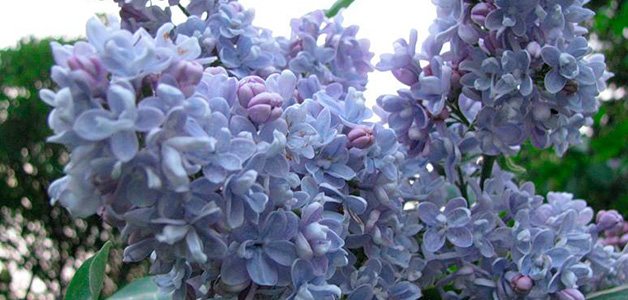

How and what to feed lilacs
Despite the fact that lilacs are very demanding on the moisture and fertility of the soil, it does not require special care. In summer, the land is watered as it dries, spending up to 30 liters of liquid per bush, and several loosening of the soil is carried out with the removal of weeds.
Top dressing depends on the age of the plant. During the first two to three years, young specimens are fed only with a small amount of nitrogen fertilizers, and from the second year they begin to apply urea or ammonium nitrate (50 grams for each bush).
Phosphate and potash fertilizers should be applied every 2-3 years. They can simply be scattered over the surface of the soil, after which abundant watering is carried out. Organic fertilizing is also considered effective, for example, slurry (1 part cow dung per 5 parts water).
Lilac care after flowering
Loosening and watering is stopped by the beginning of August, so as not to stimulate the growth of shoots. The wood must have time to ripen by winter, and for this it needs to stop growing in time.
Caution should be exercised only with nitrogen fertilizers, with an excess of which the lilac begins to fatten, that is, instead of flowering, it will begin to throw out new shoots and leaves. On the other hand, in order to bloom annually, the bush must give normal growth, which is impossible without nitrogen. Here you have to look for a "golden mean" - for example, very moderately feeding the plant once a season with urea or mullein, and do it in early spring, when the buds are just beginning to wake up.
Unlike nitrogenous minerals, phosphorus and potassium minerals will do nothing but benefit. Phosphorus is introduced in the fall, at the beginning of October, in the amount of 40 grams. for young and 60 gr. on an adult bush. This element affects the size and quality of flowers.


Potassium makes the plant winter hardy. After potash fertilization, flower buds tolerate frost well, do not freeze and the bush blooms profusely in spring. Potassium is added together with phosphorus at the rate of 3 tbsp. on a large adult bush.
Lilac loves feeding with wood ash, since this substance, unlike mineral fertilizers, does not acidify, but alkalizes the soil. Ashes are poured with cold water - 1 glass per 10 liters, insisted for 2 days and poured onto each bush, 2 buckets of such an infusion. But first you need to water the plants with clean water so as not to burn the roots.
Ash bushes are fed twice a season: immediately after flowering, when new flower buds are laid, and in October. If ash is applied, then mineral fertilizers do not need to be added in the fall.
Lilac pruning rules, whether you need to prune it
This ornamental shrub needs pruning just like other plants in the garden. But this process has its own characteristics. For example, bushes under two years old are not cut off at all, since not all skeletal branches have yet formed in them. They begin to form the crown only from the third year, and this process takes several years (Figure 5).


Figure 5. Formative and rejuvenating shrub pruning
Pruning is best done in early spring, before the onset of sap flow and the awakening of the buds. For this, 5-7 strong and beautiful branches are selected, located at an equal distance from each other. The rest of the shoots and root shoots are removed. The following spring, cut off half of the flowering branches. In this case, the remaining shoots are also shortened, leaving no more than 8 buds on them. This will help form a lush and strong shrub.
Note: Simultaneously with the formative pruning, a sanitary one is carried out, removing all dry or damaged branches, as well as shoots with signs of disease.
Lilacs can be formed not only as a shrub, but also as a small tree. To do this, you need to choose a seedling with a vertical straight trunk and, after planting, slightly shorten it (to the height of the trunk). As the lateral branches grow back, skeletal shoots are formed, leaving 5-6 of the strongest specimens each, extending to the sides. At the same time, the crown is cleaned of shoots growing inward and root shoots. Gradually, the skeletal branches will get stronger, and further pruning will include only sanitary measures and regular thinning of the crown.
Proper watering
Most species and varieties of lilacs are drought-resistant, therefore not demanding for watering. Abundant watering, as already mentioned, is needed only after planting the seedling. If the lilac was planted in the spring, then you will need to monitor the plant all summer, watering it as the soil dries up and sprinkling it with water if the foliage loses its elasticity. Sprinkling (irrigation of the crown) is carried out in the morning or evening by fine-drop spraying with water at a consumption rate of 2 liters per 1 m² of leaf surface.
See also:Watering Tips for Trees and ShrubsDuring the growing season, trees and shrubs need systematic watering until the root layer of the soil is completely moistened. In no case should the roots dry out! |
An established shrub needs watering only during the flowering period, if the weather is dry. In the event of an extremely hot summer, periodically water the lilacs both at the root and above. If the summer turned out to be generous with rains, then the plant will have enough moisture obtained with precipitation.
Closer to August, watering is no longer necessary.
Reproduction of lilac
There are several ways to replenish the number of plants in the garden with new planting material. To do this, use the methods of grafting, grafting, as well as growing from seeds and cuttings.
Each method has its own characteristics, so let's take a closer look at the key points of each of them.
Seeds
Seed propagation is used in specialized nurseries to obtain planting material of a certain variety. Some wild varieties are grown in the same way.
After collecting the seeds, they are stratified within two months by wrapping them in a damp cloth and placing them in the refrigerator. Sowing is carried out in spring or autumn, and after the appearance of several true leaves, the seedlings dive into separate containers.
It is difficult to grow a full-fledged seedling from seeds, as this process takes too long. therefore, at home, it is better to use cuttings or propagation by branches and grafting.
Cuttings
Despite the fact that the grafting method is considered one of the best, certain difficulties still exist during its implementation. The main difficulty is that lilac cuttings take root for a long time, so they need to be harvested during the most active period of the shrub's life - during flowering or immediately after its completion (Figure 6).


Figure 6. Stages of cuttings culture
In addition, you need to choose the right source material. To do this, choose young non-lignified shoots located inside the crown. They should have 2-3 internodes or nodes, and it is best to cut off the branches in the morning.
The lower cut of the cutting should be oblique, and the upper cut should be straight. The lower end is freed from the leaves and immersed in a solution of the root-forming preparation for 16 hours. After that, the planting material is placed in a container with peat or sandy soil at such a distance that their leaves do not touch. Next, you need to spray the sprouts with water and cover with a jar. The container must be transferred to the shade and periodically inspected, preventing the soil from drying out.
The first roots will appear in about 2-3 months. From this moment on, you need to regularly remove the shelter for ventilation. Planting can be carried out in the middle of summer if the sprouts have managed to form a normal root system. But, if this happened in the fall, the cuttings should be left until spring.
You will find useful tips for grafting shrubs in the video.
Root shoots
Reproduction by root shoots (branches) is also considered an effective method of obtaining high-quality planting material. To do this, in the spring, you need to choose a young shoot, which has not yet had time to woody, and drag it with copper wire at the base and at a distance of 80 cm.
Note: When pulling the shoot, it is important not to damage its bark, since in this case the layers may not take root.
Next, the prepared branch is placed in a shallow groove (no more than 2 cm), and leave the top on the surface. To prevent the shoot from being pushed to the surface, it must be fixed with hairpins. During the summer, the cuttings are regularly watered and weeds removed around it (Figure 7).


Figure 7. Features of propagation by root layers
When the shoots formed on the branch reach a height of 15 cm, hilling is carried out to about half the height of the shoots. As the branches grow, the ground is filled up, and with the onset of cold weather, the layers are separated from the mother bush and cut into several parts so that each of them has a part of the roots. After that, they can be transplanted to a permanent place, but for the winter it is imperative to equip a shelter from needles.
Vaccination
Growing new planting material by grafting is a rather complicated process for which a gardener needs to have certain skills. But at the same time, you can immediately get a large number of seedlings of the same height.


Figure 8. Features of grafting lilacs on stock
For grafting, cuttings or budding are used, and privet or a Hungarian shrub variety is used as a stock.To do this, use the method of budding with a sleeping or awakening bud (in summer or spring). In the second half of June, they begin to prepare the stock: remove all root shoots and shorten the lateral shoots so that their height does not exceed 15 cm (Figure 8).
Note: Pruning just before budding cannot be carried out, since the wound will not have time to heal and the seedling will be too weak.
Before the start of the vaccination, abundant watering is carried out for 5-6 days, and before the procedure, the place of attachment of the kidney is thoroughly wiped with a damp, clean cloth. On the rootstock at a level of 3-5 cm from the ground level, a T-shaped incision is made up to 3 cm long, the bark is carefully lifted and a bud or stalk is inserted into the resulting hole. After that, the branch must be carefully rewound with electrical tape or film for fixing.
Types and varieties of lilacs with photos
Over the past 150 years, breeders around the world have bred more than 2,200 lilac hybrids. The basis for selection is, as a rule, common lilac.
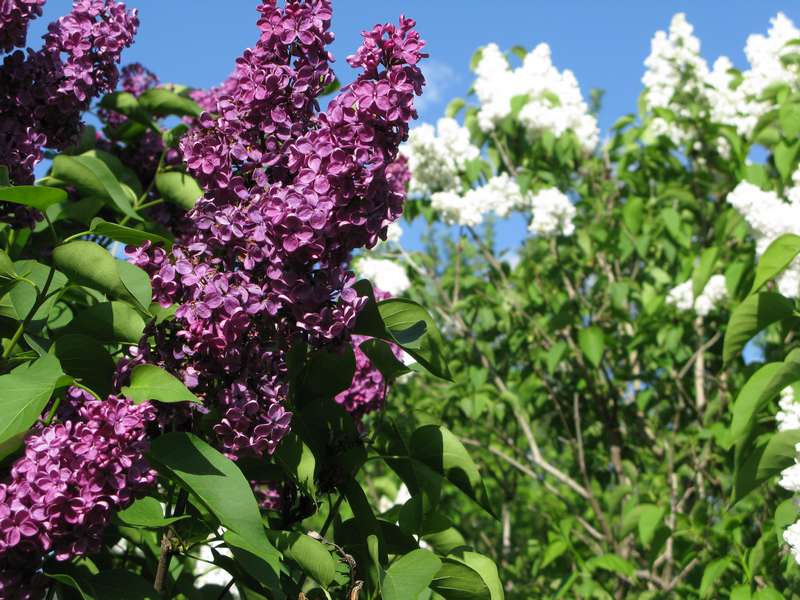

Hybrids differ in:
| inflorescence shape | simple and terry; |
| flower size | large (more than 2.5 cm), medium (1.5-2 cm), small (0.5-1.0 cm); |
| inflorescence color | white, violet, bluish, lilac, pink, magenta, purple, complex; |
| flowering time | early (early May), medium (May 12-15), late (late May-first week of June); |
| height | from 2 m to 7 m. |
Despite the listed differences, the growing conditions and cultivation methods for all varieties and hybrids are practically the same.
Persian lilac
This type is very popular among the people. But it often turns out that other varieties are also called Persian lilacs. The question arises: is there really such a variety?
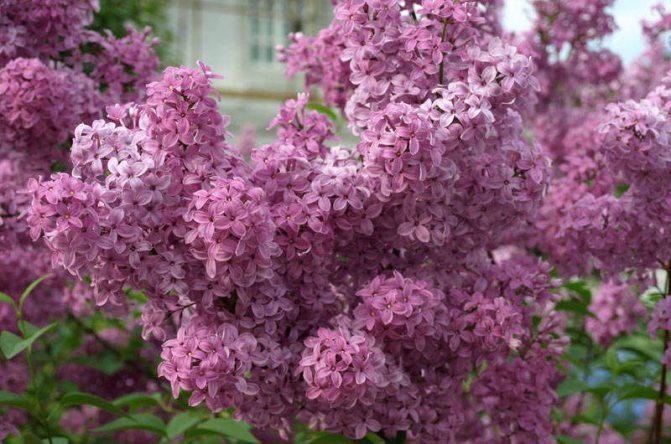

It turns out, yes, it really does exist. They brought it out in 1640, crossing finely cut lilac with Afghan lilac. The varietal standard is now kept in London.
The bush grows quite quickly, but it cannot boast of a special scope - its average height is 1-2 m, which is about 1/3 lower than bushes of other varieties.
This circumstance led to the fact that another word appeared in the name of the variety - Dwarf Persian lilac.
However, these compact shrubs have worked well in small areas, adding variety to garden plantings or as a hedge.
Yellow lilac
The yellow color of the petals is absolutely unusual for the species Common lilac.


But since 1949, breeders from Holland began to develop a new variety based on Marie Legraye, which they called Primrose (Primrose).
In the future, this variety received another name - Yellow Wonder (Yellow miracle). This is the first and so far the only species of lilac in the world with such an unusual color of flowers.
Still, it was not possible to achieve a pronounced yellow color, a distinct yellowness is noticeable only on the buds.
Blooming inflorescences are creamy, vanilla, waxy, and soon become almost white. This is due to the snow-white coloration of the parent variety.
Yellow lilac reaches a height of 3-3.5 m, blooms longer than other species (from mid-May to late June), the bush is abundantly covered with pyramidal inflorescences (up to 20 cm in length) with 2-3 tops, petals have a diameter of up to 1 , 5 cm. Primrose is distinguished by a stronger aroma.
Among the Far Eastern lilacs, there are also species with a similar cream color. For example, Amur lilac or Treskun.
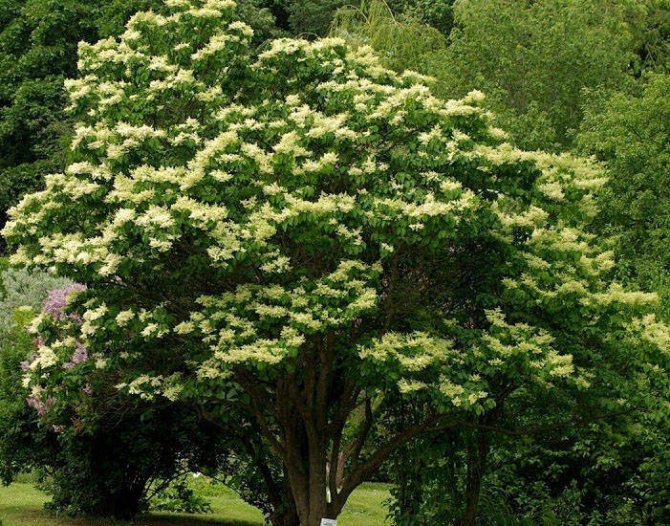

This plant is quite powerful and tall. In the harsh climate of the Far East, this species grows in the wild up to 20 m in height, however, in gardens the height does not exceed half, that is, it grows up to 10 m.
Amur lilac is a long-lived tree, its life expectancy is about a century.
Chinese lilac
Chinese lilacs were first discovered not in China, as the name suggests, but in France, in the Rouen Botanical Garden, at the end of the 18th century.


The morphological characteristics of the variety have a lot in common with the Persian lilac, so it is completely incomprehensible where this name came from.
The only difference from the Persian is in the height of the bush, in the Chinese it reaches 6 m.
It blooms with mauve flowers, the diameter of which is about 2 cm.
Inflorescences are often formed into a complex panicle, the length of which reaches 0.6-0.8 m, and which many call the "fox's tail".
Lilac Monique Lemoine


Luxurious lilac Monique Lemoine bred one of the last in the collection of varieties by breeders Lemoine in 1939.
The two-meter bush has a compact, upright crown, decorated with large white inflorescences with pointed petals.
These inflorescences usually have more than four corollas.
Monique Lemoine can be safely called the most terry of all white lilacs. Lilac Taras Bulba is also close to her in terry.
Lilac Preston
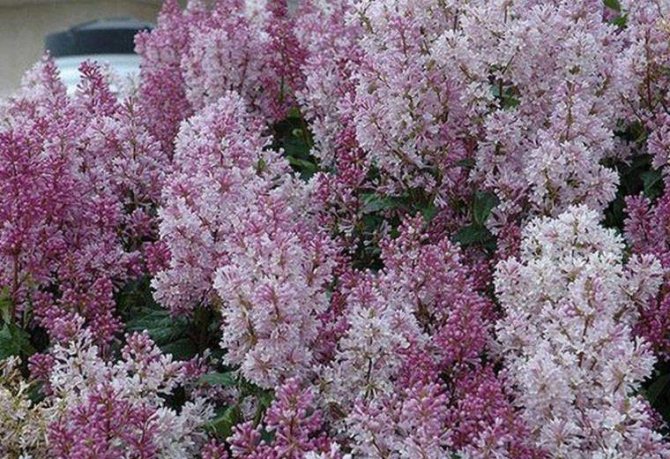

Preston Lilac is obtained by crossing two types of lilacs: drooping and hairy.
This hybrid got its name in honor of its creator - the first female breeder in Canada, Isabella Preston.
Tall (about 4 meters), strong, branched bush has increased resistance in culture, frost resistance and special decorative effect.
Meyer's lilac
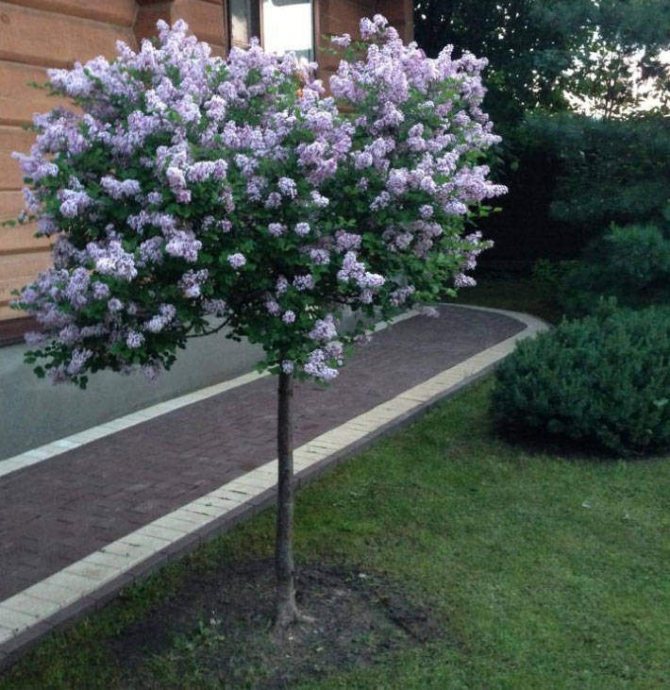

Meyer's lilac comes from the Olive family, in which there are natural and hybrid subspecies, about 40 items.
Lilac bloom begins in early May and ends at the end of June.
The height of the bush varies from 1.5 to 10 meters, depending on the variety, but, mainly, it is a low-growing dwarf lilac.
Thanks to this quality, it is possible to give the bush a standard shape, which will add extraordinary decorativeness to your site.
Life expectancy is about 90 years.
The peculiarity of this variety is its unusually strong aroma.
The plant grows in any soil, it is reconciled with a lack of moisture, it tolerates frost stubbornly. Therefore, this lilac is so popular among residents of central Russia, with a climate like, for example, in the Moscow region.
Another valuable advantage of Meyer's lilac over other species is flowering twice a summer.
True, the second flowering, which occurs in the second half of August, is not so plentiful, nevertheless, it is always pleasant to admire the blooming lilacs in the garden at an unusual time of the year.
Other varieties have the same qualities, for example, hybrid lilac Josie, Boomerang Ash.
When is it better to plant lilacs: in spring or autumn
There are many opinions regarding the best timing for planting lilacs. In fact, planting can be carried out from spring to autumn, but certain rules must be followed.
Firstly, if you are planning a spring planting, it must be completed before the sap flow begins and the buds awaken.
Secondly, with a summer planting, priority should be given to mid-July. At this time, the bushes begin to prepare for the dormant period and normally tolerate the transplant.
If you chose autumn as the planting period, it is carried out until mid-September. During this period, it is still warm enough and there is no night frost, so the seedlings will have time to take root before the onset of cold weather.
Time to board
Favorable and optimal period for planting lilacs - from late August to late September. The plant at this time is already on the threshold of dormancy: the growth of shoots stops, sap flow slows down. The ground is still well warmed up. The seedlings will have time to root well and get ready for wintering.
It's important to know
The presence of foliage on seedlings can mislead you: the leaves of lilacs last until frost and retain their green color. When the leaves have fallen off, it may be too late to start planting.
If you managed to plant the plant on time, your care is minimized: abundant watering immediately after planting and one or two more moderate watering before the onset of frost will be enough (if the weather is dry and there is no rain).


Common lilac
Pruning lilacs in autumn (after flowering) and spring
Without proper pruning, lilacs will start to run wild and degenerate in a few years. It will overgrow strongly, and all inflorescences will form only at the very top. But in the center, the bush will be empty.
There is a common belief that the more the lilac is cut or cut, the better it will bloom.This is not at all the case, so pruning must be done in accordance with very important rules and recommendations.
Note!
It is very undesirable to break out the branches of blooming lilacs. The fact is that where the inflorescence (brush) is attached, there is a bifurcation of the branches. Flower buds will form on them. If you break them down, then there will be no flowering. It would be a different matter if only the inflorescence itself was broken out, and in fact it is usually broken with a branch. Therefore, the lilac may not bloom (due to improper pruning and frequent breaking off of branches).
But!
Every spring, children and adults break off the flowering branches of the lilac, and every year it blooms magnificently again.
Indeed, its correct pruning after flowering
, namely, the removal of faded panicles in the middle of summer - in July. Thanks to this, the shrub will stop spending energy on their nutrition and the formation of seeds, the growth of young shoots is activated in it, new flower buds begin to form.
Important!
You only need to cut off the faded brush itself, without affecting the 2 lower branches, on which flower buds will form. Only in this case can you count on the most abundant and lush bloom next year.
Formative and thinning pruning of lilacs involves shortening and removing certain parts of the plant and is carried out according to the following scheme (shown in the picture):
- old inflorescences;
- too long branches;
- directed inside the bush;
- thin and weak twigs;
- old branches;
By the way!
In addition to branches that are too long and old, it is necessary to remove and
excess root growth
.
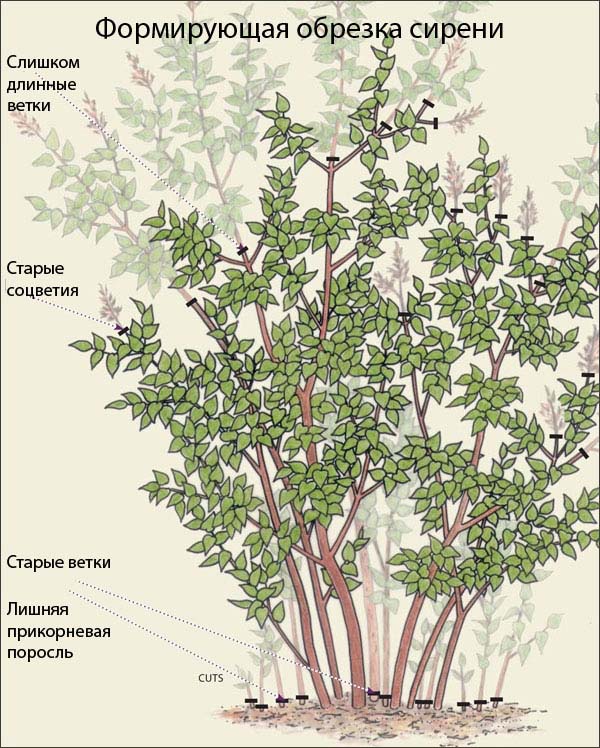

Thus, in order to maintain a beautiful shrub shape, as well as for its abundant flowering, lilac pruning should be done on a regular and systematic basis.
About, how to properly prune lilacs
, you can watch in the following video:
And additional theoretical schemes for pruning lilacs and an explanation of why you need to do this way, you will find in this video:
Of course, you shouldn't forget every spring and perform sanitary pruning
deleting all
damaged and dry branches
.
If you received an old and overgrown lilac along with the site, then in order to bring it back to life, you need to carry out its rejuvenating pruning. As for the timing, it is usually recommended to do this in early spring or after flowering.
The essence of "cardinal" cropping is shown in the picture. Namely, you need to cut off all old branches very strongly and low, as well as completely get rid of excess root growth.
However, it is not necessary to cut the lilac so much to rejuvenate it: it is enough just to shorten all branches to the required length, but first thin it out (completely remove excess thickening shoots, as well as root growth).
Yes, this and / or next year will no longer bloom such lilacs, but in any case you will have to sacrifice something.
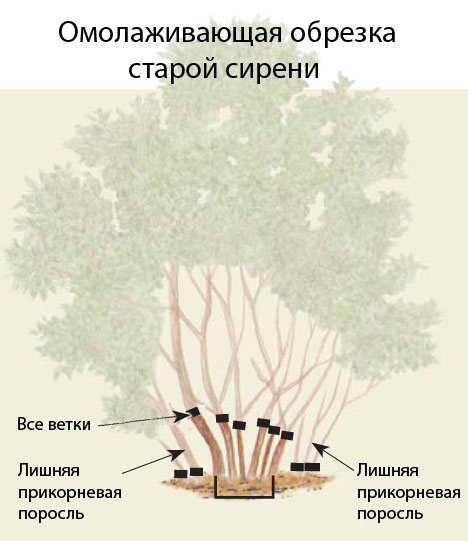

Basic rules for care in the fall
In dry weather, lilacs require periodic watering. From fertilizers in the fall, lilacs can be fed with rotted manure. This will improve the flowering quality of the plant. You should not feed the bush shortly before the cold weather (about 2 weeks).
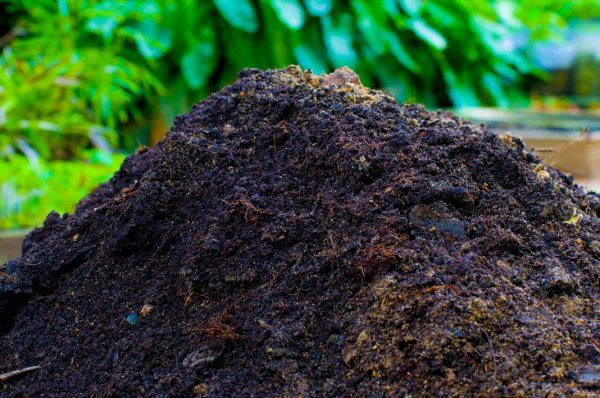

Lilacs are not suitable for high pH soils. In this case, it blooms poorly. To reduce acidity, the trunk circle is covered with dolomite flour, ash, chalk or crushed egg shells.


After the substances are scattered near the bush, the periosteal circle is dug up. Directly near the trunk, the shovel is deepened by 5 cm, and from a distance of 50 cm and further, the digging depth is increased to 10 cm.
Cutting shoots in September
This vegetation thickens very quickly, which means that light practically does not penetrate to the inner stems, and therefore there is a significant deterioration in vitality.Then the garden culture can become a breeding ground for harmful insects, and excellent conditions are created for various kinds of diseases. To avoid such consequences, it is necessary to cut the shoots from the second growing season.
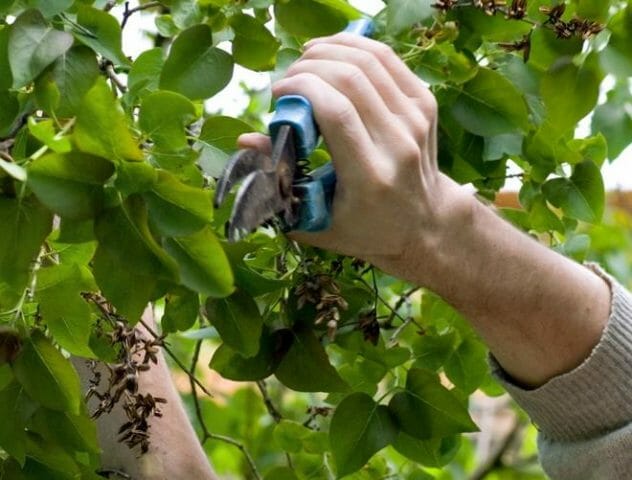

Pruning lilacs in autumn
Care after landing


Formation of a lilac bush in the shape of a tree
As mentioned earlier, lilacs can be grown without knowledge and skills in the field of gardening, since this plant is absolutely unpretentious. However, if these recommendations are followed, the ornamental shrub will be beautifully flowering and lush for a rather long period of time.
Top dressing of lilacs
If enough superphosphate, ash and compost were added to the planting hole when planting lilacs in the fall, fertilization should be started from season 2 if it is nitrogen microelements and from season 4 if it is organic.
Phosphorus and potassium nutrients are introduced in the autumn months no more than 1 time in 2-3 years.
This plant responds very well to wood ash, which can easily replace top dressing with various fertilizers. It is better to introduce it in liquid form, after stirring 200-300 g in a bucket of water.
Watering and loosening
During flowering and active growth, lilacs should be watered quite often. As soon as the soil dries up, you can safely moisten the soil.
The optimum depth of loosening the soil under the lilac is 5-8 cm, and the frequency of the procedure is 3-4 times per season.
Pruning
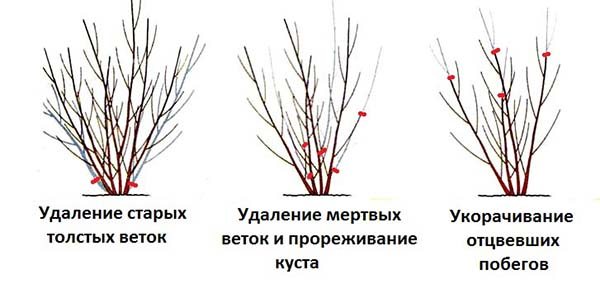

How to prune lilacs in the fall
Lilacs can be grown as a shrub or as a tree. To give the bush a lush shape, for 3-4 years after planting the lilac, 8-10 of the most even and beautiful branches are left, and everything else is cut off. In this case, the main shoot is also shortened.
If you want to make a tree out of lilac, only the strongest branch is left. All kidneys located below 60-70 cm are cut from it and 7-8 upper pairs are left. Then one of the paired branches is plucked out and no more than 7 branches remain.
Sanitary and thinning pruning is best done in early spring, but can be done throughout the season if needed. In order to obtain bulky bunches, flower buds should also be partially cut off.
Pruning ornamental shrubs
Lilac is one of the few ornamental plants that does not require special care and looks gorgeous. This shrub takes root well not only in the Moscow region, but also throughout the middle zone of the country.
Lilacs, with their unique scent that cannot be confused with other plants, boasts a reputation as one of the easiest garden shrubs to grow. Lilac adapts perfectly to a wide variety of climates, settles in gardens for decades, is frost-resistant, gas- and drought-resistant. But it would be a very big mistake to call lilac a culture that does not require care at all. After all, this shrub retains both abundance and beauty, only if you give it at least minimal care.
Dwarf lilac in a flower garden. <>
Does lilac need care?
Lilac is a shrub with an almost impeccable reputation. It copes well with frost and urban conditions. Not afraid of dust and gas pollution, not demanding on soils, adaptable to lighting. You can even use lilacs in the design of the garden in different ways: there is a place for this beautifully flowering shrub in the alley, and in the hedges, and on the lawn, and in the flower garden or rabat. But lilac does not belong to the plants that can be “planted and forgotten”.
To admire its fragrant clouds, you need to devote time to pruning every year. And it will be impossible to achieve abundant long flowering without watering, fertilizing, maintaining the proper condition of the soil. Lilac care is not difficult, but it consists of the minimum procedures necessary for the normal development of the bush. There are important rules here.
Rule 1. Watering not only after planting
Lilacs are considered so hardy that they don't need regular watering.Systemic procedures are not needed for this shrub, but this does not mean that irrigation for lilacs is not carried out at all. Care is not limited to the first procedure of abundant watering after planting.
Watering lilacs is carried out during the entire flowering time and in spring during the active growth of shoots (of course, only when natural precipitation is not enough). In the summer, after flowering, watering is carried out only on the hottest days: the plant is not afraid of drought, but it still needs to be protected from overheating.
Watering lilacs is carried out throughout the active season.
Lilacs need a different approach to feeding immediately after planting and after reaching optimal sizes. These plants cannot be fed until they are fully rooted and in preparation for winter: lilacs are fed only during the period of active growth, in the first half of the season.
In the first year after planting and at a young age, lilacs do not need feeding. The only exception is planting in poor soil, which simply does not have enough nutrients for normal growth. In this case, for young lilacs, two dressings are applied per year. After winter, when signs of the beginning of the growth of young branches are visible on the bush, the first feeding is carried out. And the second is held in the middle of summer: in late June or early July. From the second year after planting in early spring, nitrogen or organic fertilizers can be applied to any lilacs.
Adult lilacs are fed differently. From the third or fourth year, 1 time per season (most often in early spring), 50-60 g of nitrogen fertilizers (ammonium nitrate or urea) are applied under each bush. In the summer after flowering, lilacs are fed with organic fertilizers, embedded in the soil with a solution of mullein or ash. "Autumn" top dressing (in August-early September) is applied only once every 2-3 years, using potassium-phosphorus fertilizers (30 g of phosphorus and potash fertilizers or 55-60 g of the mixture).
For any lilacs, you can mix organic and mineral fertilizers. For young lilacs, manure is preferable, for adults - humus. When combined with organic matter, a single portion of mineral fertilizers should be reduced from 50-60 g to 30-40 g.
Lilacs are fertilized only in cloudy weather or in the evening, after watering or rain. Fertilizers can be either dissolved in water or embedded in the soil.
Rule 3. Three types of lilac pruning
If something is lilac and "simple", then just not in pruning. After all, this beloved shrub needs regular cleaning and shaping. Pruning begins from the third or fourth year, when skeletal branches begin to form. And a single pruning is not enough; for lilacs, as many as three types of these procedures are carried out:
1. Basic trimming (stimulation of flowering) is necessary for all types of lilacs, without exception. In order for the bushes to bloom profusely next year, it is necessary to prune the faded inflorescences in time, because flower buds of this shrub are formed only on summer shoots. The main pruning is done immediately after flowering, rather than in the fall.
2. Anti-aging pruning... It is only needed on adult and old lilacs. Timely rejuvenation avoids the need for cardinal rejuvenation and skipping flowering. For rejuvenation, thickening, excess shoots on the bushes are removed annually, forming strong skeletal branches and a healthy bush with 5-10 well-located shoots.
Such rejuvenation is carried out in early spring, before the awakening of the kidneys. But if, nevertheless, it became necessary to carry out a radical rejuvenation on old lilacs, then all shoots, without exception, are cut to sufficiently low stumps, completely removing all unnecessary thickening branches. Next year, the lilac will recover and if it releases inflorescences, then only small and single ones. But every year, with the proper formation of the bush, the lilac will bloom more and more abundantly and more beautifully.
3. Formative pruning... Lilac is a mostly landscape and picturesque shrub, and the formation of the crown, giving it certain outlines on it is used very rarely. The only exception is the removal of root shoots, weak, growing inward, damaged, dry shoots, which is necessary for any lilac to form strong skeletal shoots.
And the formation as such is carried out only in three cases:
- in regular gardens, lilacs are given a stricter shape, from a young age setting the growth vector and slightly trimming the shoots to limit the growth of the crown and give a silhouette (for example, for a spherical and umbrella-shaped crown, the lower shoots are removed and the upper ones thicken, etc.);
- for hedges and tunnels near densely growing bushes, the top is cut off, and on the side shoots, twice a year, in spring and autumn, they are pruned, achieving the desired hedge outlines;
- to form a lilac in a bole, one central skeletal shoot is left, it is regularly "cleaned" from lateral branches, and the crown is formed at the top into a "cloud", limiting its growth.
The main pruning of lilacs is carried out immediately after flowering.
In order for lilacs to please with abundant flowering for many years and not suffer from any weather conditions, it is necessary to keep the soil loose, constantly renew its air and water permeability. Without loosening the soil, the lilac will suffer from soil compaction.
Loosening the soil for lilacs is carried out 3 or 4 times per season, combining it with weeding. The first loosening is carried out in early spring. It is better to carry out aeration after heavy rainfall or watering. But it is extremely important not to overdo it: for lilacs, the soil is loosened only 4-7 cm and no deeper.
Rule 5. Mulching is very important
It is possible to simplify the care of lilacs as much as possible and achieve better moisture retention, protect the root system from overheating, preserve the quality of the soil and its structure, only if you do not forget to constantly maintain the mulching layer in the lilac trunk circle. The first mulching for this shrub is created during planting, or rather, after abundant watering. For lilacs, the mulch layer should be from 5 to 7 cm. In the future, the mulch layer is renewed and maintained constantly, renewing at least 2 times a year - in spring and autumn.
As mulching materials for lilacs, it is preferable to use:
- peat;
- humus;
- half-ripe leaves;
- compost.
For young seedlings in the first winter, it is advisable to create a new protective mulching-covering layer of leaves or peat up to 10 cm high.
Lilacs in the garden.
Despite its reputation as a strikingly hardy shrub, lilacs suffer from both disease and pests. Moreover, problems on healthy and strong bushes can appear in the vicinity of infected plants, and in unsuccessful seasons, when the care was insufficient to compensate for the heat and drought. And it will be very difficult to cure lilacs if you do not notice the defeat in time. Inspect the bushes regularly, especially in the second half of the season, for the slightest sign of these troublesome problems.
Of the diseases on lilacs, late blight and powdery mildew are most common. The sooner a problem is identified, the easier it will be to deal with it. With a strong defeat of lilacs, it will be difficult to cure it even with cardinal pruning and regular treatments. You can fight diseases on this shrub with a simple Bordeaux mixture and a variety of narrowly targeted fungicides.
Of the harmful insects on lilacs, leaf-eating pests and mites are more common. Moreover, the spread of these pests leads to a rapid loss of decorativeness and practically - to "baldness". It is necessary to fight insects with systemic insecticides: narrowly targeted agents are effective, but while you are struggling with one problem, other pests can settle on the weakened lilac.
Lilac is a perennial shrub with lush, bright inflorescences.Since the elegant plant has a high decorative effect and is absolutely unpretentious in its care, it can be found in almost every yard. But in order for it to turn from a familiar bush into an exquisite plant strewn with flowers, it needs to be looked after not only in spring and summer, but also in autumn.
In this article, you will find answers to the questions: is it necessary to prune lilacs in the fall and how to properly care for the plant.


Lilac (Syringa)
Lilacs are shrubs of the Olive genus. There are a huge number of its varieties, which differ in height, shape, color of petals and other characteristics. Breeders continue to work on developing new varieties - they have a bright color of flowers, as well as a high degree of resistance to pests, bacterial and fungal infections.
Lilac prefers slightly acidic and neutral soils that allow air and moisture to pass through well. However, it can also be planted on less fertile soils. The main condition for its rapid growth and abundant flowering is the timely application of organic and mineral fertilizers.
Lilac shelter for the winter
Shelter is an important part of caring for a plant in the fall and preparing it for winter. Warming is very important for young lilacs. Before mulching the soil, the trunk of the shrub is wiped with a rag in order to cleanse it of dead scales and accumulated dirt. For the prevention of diseases and pests, the treated wood is whitened.
Do I need to cover lilacs for the winter
Young and transplanted bushes are not yet strong enough to withstand the winter cold, so they need to be insulated before winter. Otherwise, flower buds and roots located near the surface may freeze out of plants. Mature bushes are endowed with good frost resistance, so they do not need shelter.
How to properly cover lilacs for the winter
After the temperature drops to -5 C at night, the trunk circle of the shrub is mulched with a 10 cm layer of straw, sawdust or dry leaves. As a result of a short stay in moderate frosts without shelter, the young plant will harden and acclimatize to new weather conditions. The trunks of the boles are wrapped in double-folded burlap.
Description of the budley
In the wild, the budley of David grows in China in the mountains and along the river banks. Budleia is a deciduous, beautifully flowering shrub, the height of which can reach one and a half to two meters. Budleia has flexible, thin, arched branches at the ends, which bloom lush inflorescences. Varietal budleys have blue-purple, bright crimson, purple-red, lilac-blue, deep purple, white or lavender inflorescences with an orange seridin. The inflorescences of wild plants also have a bright orange center, and their color is dark purple. The leaves are dark green, with pointed ends, twenty-five centimeters long. The underside of the leaf is silvery gray. The bark on old branches becomes gray and cracked. On one branch in the fall, buds, flowers and even fruits may be present.
Pruning in the fall
For any shrub, pruning is a very important step, which strengthens the plant and improves its flowering. Before proceeding with the cultivation of a favorite shrub, you need to familiarize yourself with the technology of manipulation, so that care does not harm, but certainly benefits. Lilac care in the fall may include pruning. But you need to do it right! Let's figure out how.
Why prune lilacs
Regular pruning is essential to:
- the shrub bloomed luxuriantly: regular pruning causes the budding of flower buds;
- give the bush a beautiful shape;
- prevent the emergence of diseases and pests, the risk of which increases significantly on heavily thickened plants;
- equalize the splendor of flowering old and young branches.
When is the best time to prune lilacs - in autumn or spring
Novice and inexperienced gardeners often wonder when is the best time to prune lilacs, in spring or fall. Experienced gardeners recommend pruning in March or May after flowering ends. The manipulation stimulates the laying of flower buds, which will be fully formed by winter, and in the next season the lilac will bloom magnificently.
So can lilacs be pruned in the fall? Pruning in autumn or winter is undesirable: there is a high probability that shoots with flower buds will be removed along with unnecessary branches. If pruning in the fall is incorrect, then next year it will bloom very poorly.
Important! Pruning lilacs in the fall should be especially careful, and if there is very little or no experience in the cultivation of shrubs, it is better to postpone the manipulation until spring.
Video: how to properly cut lilacs in the fall.
Timing of pruning lilacs in autumn
As a rule, the timing of pruning plays an important role. And when is the lilac cut for the winter? You can prune the plant in the fall at any time. The main condition for starting manipulation is dry and cloudy weather.
How to properly cut lilacs in the fall - instructions and diagram
In order to give the lilac a beautiful shape, it is necessary to regularly cut off the protruding branches. And how to properly cut it in the fall? It is necessary to observe the following sequence of actions during the formative pruning of lilacs:
- Cut off dry, diseased and damaged shoots, as well as shoots, the growth of which is directed to the center of the bush.
- The bush is thinned out: of two closely spaced branches, only one is left.
- Shoots growing near an adult plant are removed.
- During the second formative pruning, the skeletal branches directed towards the center of the plant are cut and all other shoots are shortened by 1/3.
- For 3-5 years from the beginning of crown formation, the same manipulations are carried out.
- In subsequent years, after establishing the shape of the crown, old and diseased branches, as well as part of the branches, are carved out of the bush.
Video: a diagram of how to prune lilacs in the fall.
Important! It is possible to start the formation of a lilac crown only 3 years after planting.
Pruning old lilacs
To bring the old lilac back to life, it is necessary to cut the overgrown bush in the fall. Due to rejuvenating pruning, young shoots will receive more moisture and nutrients, and the plant will take on a more beautiful appearance.
How to prune old lilacs in autumn? Pruning an old plant is done like this:
- Cut off old shoots covered with cracked bark. Even those branches on which there are live shoots are subject to removal.
- If the plant needs to be given a bush shape, only 3-4 shoots are left, directed in different directions.
- If you want to get a tree from a spreading bush with a crown in the form of a ball, cut off all the lateral shoots, and cut off part of the top the next autumn. In all subsequent years of growing the stem, the shoots that form on the trunk are cut off.
- In the following seasons, after pruning, excess branches are cut out of the bush.
Video: old lilacs requiring pruning.
In the photo below, you can see a scheme for rejuvenating pruning of old lilacs in the fall:
Important! Regardless of the type of pruning, during manipulation, no more than 15-20% of the branches of the original amount can be removed.
Video: lilac pruning scheme.
Post-pruning care: feeding and fertilizing
Due to the peculiarities of the lilac and the large diameter of the sections, the resulting wounds heal for a very long time. Therefore, in order to block the path of pathogenic bacteria inside the trunk, they need to be treated with garden varnish.
To prepare the mixture over low heat, melt rosin and wax (1: 2) in one bowl. As soon as they acquire a liquid consistency, pour in 2 parts of oil. After mixing thoroughly, the mixture is removed from the stove and slowly poured into cold water. Then the water is drained and the var is left to dry slightly. The resulting mixture is treated with cracked sections.
By the way! Instead of garden varnish, you can use oil paint or brilliant green.
After the end of pruning, a multicomponent organic solution is introduced under the lilac (the recipe is indicated above).
Care features
For young lilac bushes, 2 feeding a year is enough: upon awakening in spring and after the end of flowering. When the plants reach 4 years of age, nitrogen fertilizers are recommended to be applied more often. The optimal frequency of feeding adult shrubs is 4 times a year, taking into account their nutrient needs during the growing season.
When landing
During the planting of seedlings, the soil is fertilized with organic and mineral substances. It is also important to ensure good conductivity of the soil for water and air. Several ingredients are added to the planting pit:
- drainage from stones or gravel;
- for acidic soils - lime or dolomite flour;
- to regulate water permeability - clay (into sandy soils) or sand (into clayey);
- organic matter - manure, compost, humus, bone meal;
- mineral fertilizers - superphosphate, potassium fertilizers.
Advice! In the first 2-3 years, mineral fertilizers are not used. However, organic mixtures can be added periodically to stimulate growth.
For flowering
At the beginning of bud formation, it is recommended to apply about 20% of the annual nitrogen requirement. However, you can do without using it. Solutions with wood ash are no less useful during the budding period. Dry ash is diluted with water in a ratio of 100 g per 5 liters and used for irrigation.
During flowering
During the period of mass blooming of flowers, lilacs need an additional portion of nitrogen fertilizers (about 20% of the annual norm). It is also helpful to use potash and phosphate mixtures. It is undesirable to apply organic fertilizers in this phase, since they can provoke a decrease in flowering intensity.
After flowering
At the end of the flowering period, when the life processes of lilacs stop, it is important to restore the composition of the soil. Autumn feeding is one of the two main ones and requires the introduction of all the necessary substances in the maximum dosage. However, nitrogen compounds in this phase are undesirable - they can provoke the growth of young shoots before frost. In addition, it is useful to thin out the crown, remove dried and non-viable branches.
Pick-up location
Although the lilac is unpretentious, when choosing a place for this shrub on your site, you should adhere to the following recommendations:
- the soil should be moist and temperate;
- groundwater is not higher than 1.5-2 meters from the surface;
- acidity should be neutral;
- the presence of sunlight for most of the day;
- protection from strong winds.
Lilacs are best planted on a small slope or flat area with good drainage.
Lilac: planting and care in the open field
It is recommended to plant lilacs on neutral or slightly alkaline soils; too waterlogged soil can cause the death of the plant.
The landing site should be well lit; with a lack of sun, plant growth will be slow, flowering may be absent. Strong sunshine can cause the appearance of small and rapidly flowering inflorescences in lilacs. The best place for planting is a sunny, well-protected place from the winds.
Planting lilacs should be carried out in late summer - early autumn, preferably in the evening or damp, cloudy weather. The depth of the planting hole, dug in advance in 2-3 weeks, is recommended from 0.5 to 1 meter with the same width. When planting, it is imperative to add organic fertilizers, wood ash or humus to the soil (up to 20 kg per planting pit).
High-quality flowering will be observed with normal growth, which depends on how correctly the lilac is maintained. Planting and caring, if carried out correctly, combined with love for the plant, will lead to its continuous gorgeous flowering and active growth.
Every autumn, the soil needs to be dug to a depth of about 12 cm, carefully so as not to damage the roots of the plant. For the winter, the dug up soil should be left unleveled so that the weed seeds in it will freeze over the winter.
Top dressing of lilacs is done in early spring, as soon as the shoots begin to grow back. A mineral complex is introduced under one bush, consisting of 20-30 grams of ammonium nitrate, 30 grams of superphosphate, 15-20 grams of potassium chloride; the planting depth is 10-15 cm. It is recommended to fertilize with mineral fertilizers simultaneously with the introduction of mullein or slurry.
The second feeding is carried out during the period of bud formation with the same composition.
Correct pouring
Before wintering, lilac bushes, like many other vegetation, need good watering, although it grows calmly during periods of drought. You do not need to do this if the fall is rainy. But if there was no precipitation in September and the first half of October, be sure to water abundantly so that the earth is saturated with moisture by at least 50 cm.
Thus, you will not spend a lot of effort to prepare the culture for winter, just 2 bushes takes about 2 hours. But this care will give you lush bloom and wonderful aroma of these flowers next year.
Foliar top dressing of lilacs
The plant also prefers foliar treatments. As a rule, such feeding of lilacs is carried out in summer and autumn. Agricola is suitable for a flowering bush. A solution of micronutrient fertilizers is prepared as follows:
- the contents of the package 25 g are dissolved in a bucket of warm water;
- pour the nutrient mixture into a spray container;
- all leaves are carefully processed.
Instead of a ready-made fertilizer, you can make the composition yourself. To do this, you need 1 g of copper sulfate, 5 g of manganese, 2 g of zinc sulfate and the same amount of ammonium molybdate. The amount of powder is calculated for 10 liters of water. The solution is enough to process several lilac bushes.
Important! It is necessary to feed lilacs by foliar method only after flowering.
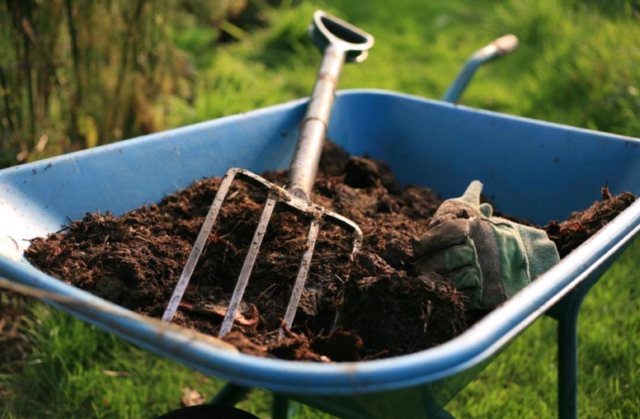

Do I need to fertilize lilacs?
Lilac is a rather unpretentious plant that can grow and develop well on almost any soil. But for lush flowering, it needs additional processing. Top dressing of lilacs is carried out twice a year - in spring and summer. This is enough, but additional treatments can be carried out, which will contribute to the formation of flowers.


Lilac is an unpretentious plant that develops well on any soil
The need for anti-aging pruning
This procedure is necessary for old bushes, which are more than 10 years old. During this time, the appearance and signs of varietal affiliation are lost. Signs of illness appear. You can return the lilac to its former appearance and rejuvenate it as follows:
- remove stems without bark, cracked, diseased or broken off;
- removing almost everything, except for 3-4 good stems, which does not grow in the center, the rest is absolutely unnecessary;
- process the cutting sites with pitch, but it is better to sprinkle with crushed coal.
- For the next 2 years, the vegetation is well fed and watered.
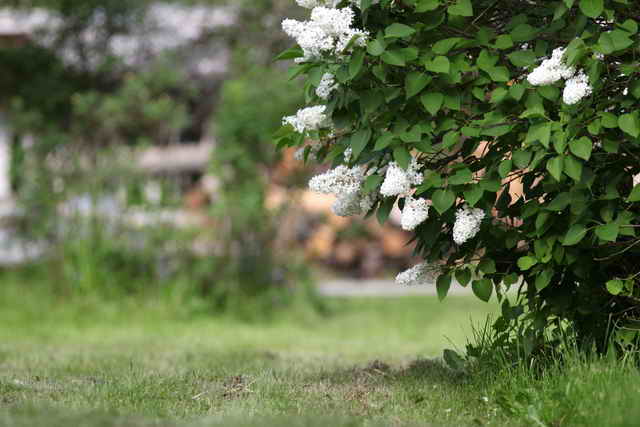

Rule 6. Persistent does not mean invulnerable
Despite its reputation as a strikingly hardy shrub, lilacs suffer from both disease and pests. Moreover, problems on healthy and strong bushes can appear in the vicinity of infected plants, and in unsuccessful seasons, when the care was insufficient to compensate for the heat and drought. And it will be very difficult to cure lilacs if you do not notice the defeat in time. Inspect the bushes regularly, especially in the second half of the season, for the slightest sign of these troublesome problems.
Of the diseases on lilacs, late blight and powdery mildew are most common. The sooner a problem is identified, the easier it will be to deal with it.With a strong defeat of lilacs, it will be difficult to cure it even with cardinal pruning and regular treatments. You can fight diseases on this shrub with a simple Bordeaux mixture and a variety of narrowly targeted fungicides.
Of the harmful insects on lilacs, leaf-eating pests and mites are more common. Moreover, the spread of these pests leads to a rapid loss of decorativeness and practically - to "baldness". It is necessary to fight insects with systemic insecticides: narrowly targeted agents are effective, but while you are struggling with one problem, other pests can settle on the weakened lilac.
What are the features of preparing for winter in different regions
Depending on the climate, young lilac bushes are covered in different ways. The severity of the shelter also depends on the shape of the plant: the stems are more susceptible to frost damage, and the bushes are more susceptible to damage from mice.
In the middle lane (in the suburbs)
In order for the plant to overwinter well, an ordinary shelter is quite enough for it.
In the Volga region
The plant is mulched with a 15 cm layer of spruce branches or straw or replaced with boards, which are laid along the perimeter of the rhizome. If the bush is planted in a windy place, it is wrapped in dense material.
In the Urals and Siberia
The thickness of the mulch layer increases to 15-20 cm, and young bushes are wrapped with agrospan. In the northern regions, lilacs can damage not only the fierce cold, but also hungry mice. To protect the root collar from damage, the bush is covered with snow, and then carefully crushed. In order to protect it from rodents, the trunk is tied with spruce branches.
Important! To prevent the lilacs from straying out, the shelter must be removed immediately after stable warming has been established.
Etymology of the plant name
Lilac got its name from the Greek word "syrinx", which translates as "pipe", as shepherds cut a pipe from its wood in the form of a tube. Anyone who is fortunate enough to hear her sound will not forget her tune all his life.
In Russia, Lilacs were called "Chenille", which means "blue" - one of the main shades of plant inflorescences. In Turkey, the shrub is referred to as "Lilak", and the inhabitants of Germany, Flanders and Austria gave it the name "Lilac" or "Turkish Kalina".
What fertilizers to use for lilac bushes
Why is it better to use organic matter if there is a huge selection of mineral mixtures in stores:
- Organic matter is not only plant nutrition, but also the quality of the soil. The decomposition of plant and animal residues is carried out by soil bacteria, for which they serve as food. In turn, the processed substances contain nutrients for plants that can be absorbed. Thanks to organic matter, the earth is looser and air-permeable.
- Plant substances take longer to decompose and gradually release food into the soil, in contrast to minerals, which dissolve quickly, but are just as quickly washed out of the upper layer.
The disadvantage of organic fertilizers is the high price or their lack, since even in the village not everyone is engaged in raising cattle or poultry.
Green manure as fertilizer
Manure can be successfully replaced with commercial compost or green manure. If there is a garden bed on the site for growing green fertilizer, then this will save money on the purchase of manure. Greens of green plants are used in different ways:
- Placed in a barrel, poured with water and brought to fermentation. Then the flowers are watered with this infusion.
- Sow under bushes after flowering. When they grow up, they cut and mulch the earth or dig it up with the top layer of the soil.
- Sown at the end of September. Plants freeze and decompose in winter, and in spring they serve as food for ornamental crops.
Planting and forming a bush
For planting lilacs, a pit is made, at the bottom of which the following mixture is laid:
- 300 - 500 g of ash;
- 200 g bone meal;
- 500 g superphosphate;
- 100 g of potassium sulfate;
- a bucket of humus.
A bucket of compost is poured from above, and a seedling is installed on it. The pit is sprinkled with earth and tamped, then watered.
For the next 3 years, you can forget about feeding. The focus is on the formation of the bush. If you grow a standard view, it means that the lower and upper branches are cut, leaving the crown to grow in width. If you need a shrub, you need to do as follows:
- cut off all dry inflorescences;
- remove the growth at the bottom so that the bush does not grow in width;
- the longest branches growing upward are cut by 1/3.
By spring, the shrub will have a round shape, and inflorescences will form on the new shoots.
If you can find something to feed the lilac in the fall after pruning, the whole bush will be strewn with flowers. Only the main attention should be paid to potash-phosphorus fertilizers.
Pruning old lilacs
Old lilac bushes need rejuvenating pruning. For this, almost the entire above-ground part is removed.
A cut stump remains. It is advisable to treat the place of the saw with a garden pitch so that bacteria do not start or beetles do not settle in the wood. For the winter, the stump must be mulched with fallen leaves or bark, previously treated with a strong solution of urea from pests.
The neglected lilac bushes, living without care for a long time, thicken and bloom weakly. This is fixable! The first step is to carefully cut out the oldest trunks with peeling bark to the soil level. But not all at once, but in two or three years. The strongest shoots should be left from the emerging growth. During this period, top dressing will come in handy, even if the lilac used to sit on a "starvation diet".
Pests and diseases
If the lilac bush dies off starting from the tops, the leaves brighten and fall off, curl and become brittle, or light spots of an indistinct or annular shape appear on them, this is probably a viral infection. These plants are uprooted and burned, and the soil is replaced. And lilacs have not been planted there for several years. But usually lilac does not cause any special problems.
To combat the scale insect, lilac speckled moth, hawk moth, moth, and mites, insecticides and acaricides approved for use in private households are suitable: fitoverm, fufanon-nova, aktara, alatar, etc.
And from late blight of the kidneys (when some die off, others have time to open, but the inflorescences of them curl and dry out) have long been using 2% Bordeaux liquid. Processing is carried out before the dissolution of the buds and after leaf fall.
The best protection against fungal diseases and the spread of harmful insects is prevention. The minimum program is the collection and burning of twisted, stained and fallen leaves, removal of dry shoots, careful (no deeper than 4-5 cm) digging the soil under the bushes in the fall with a turnover of the layer.
How to choose planting material
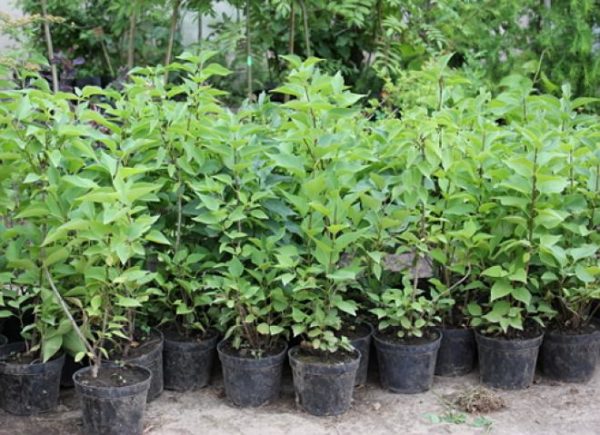

According to the botanical description, lilac is a deciduous shrub, reaching a height of 5-8 m. The genus has 30 species and more than 2300 varieties. Gardeners appreciate the plant for its large, fragrant inflorescences. Bushes can be grown on or without rootstocks. Own-rooted crops grow well in the temperate climate of the central regions of Russia. It is easier to care for such plants. They are more durable and stronger, do not degenerate into a wild form, quickly recover after freezing.
Bushes with open roots should be immediately planted in a permanent place. Therefore, the time of purchase must be timed to coincide with the dates favorable for disembarkation. Before purchasing the seedling, carefully examine it. The roots should be intact, well branched, and the stems should be free from signs of diseases and pests. Saplings no older than 3 years old, 50-70 cm high, take root better.The diameter of the root lobe should be about 30 cm.
Rule 4. Loosening the soil should be regular
In order for lilacs to please with abundant flowering for many years and not suffer from any weather conditions, it is necessary to keep the soil loose, constantly renew its air and water permeability.Without loosening the soil, the lilac will suffer from soil compaction.
Loosening the soil for lilacs is carried out 3 or 4 times per season, combining it with weeding. The first loosening is carried out in early spring. It is better to carry out aeration after heavy rainfall or watering. But it is extremely important not to overdo it: for lilacs, the soil is loosened only 4-7 cm and no deeper.
Application of buddleya in landscape design
Culture is actively used to complement flower gardens, creating bright accents in the territory. Against the background of such a bush, roses, conifers, evergreen representatives look harmonious.
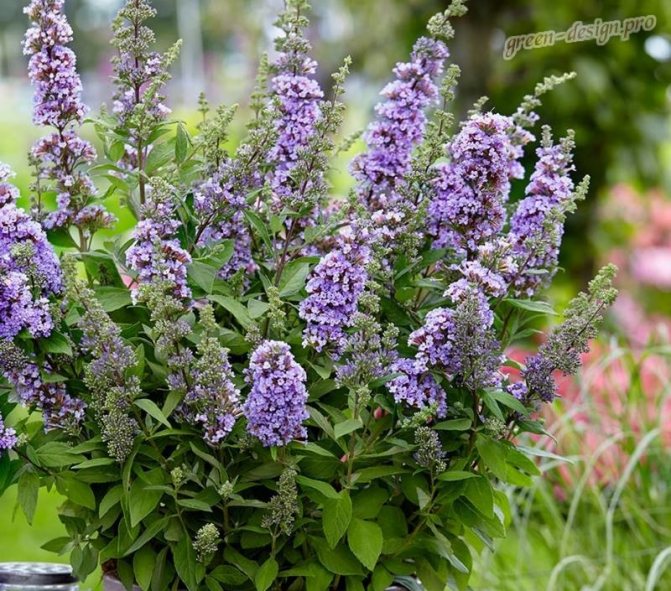

Miniature varieties look harmonious in pots placed next to a pond or garden path.
You can decorate the recreation area with Buddley by placing a bench in the center, and planting bright bushes around. They are also often used to decorate terraces.
Plant diseases and pests
For those who want to acquire a chic, pleasantly smelling plant on their own plot, it is worth knowing everything about this culture: what are behind such a plant as lilac, planting and care, its diseases, pruning timing and watering regime. Pests and diseases rarely affect lilacs. This is a lilac miner moth, the target of which is the leaves of a bush. After exposure to this insect, the lilac looks as if burnt and practically does not bloom the next year. Fight against such a pest should be by deep digging of the soil under the bush in autumn and spring (in order to destroy the pupae that have settled in the soil), cutting and burning the affected shoots.
Also, lilacs, planting and caring for which bring a lot of joy to true lovers of beauty, is sometimes struck by bacterial necrosis; this happens in early August. The disease is transmitted by irrigation water, insects, planting material. You can determine the presence of this disease by gray leaves and brown shoots. In this case, the use of drugs aimed at pest control, removal and disposal of damaged plant parts, uprooting and burning of heavily affected bushes is required.
Lilac belongs to unpretentious plants that look great not only during flowering. In the autumn period, the foliage remains on the ornamental shrub for a long time, attracting the views of household members. Planting lilacs is not difficult. She takes root quite well and does not require special care after planting.
Fertilizers and feeding
It is recommended to start feeding lilacs from 2-3 years of her life. Immediately after planting, caring for the shrub consists only in watering it during periods of drought, as well as in loosening the soil and removing weeds. The only thing is that when planting, you can prepare the soil in advance and add complex mixtures (wood ash, superphosphate, potassium compounds, manure or humus) to it.
Advice! If fertilizers are applied under a young bush, they can injure the root system. In the first few years, it will have enough nutrients from the soil, and then the rhizome will already be strong enough.
In the spring
The first feeding is carried out in early spring, after the awakening of the shrubs. During this period, it is useful to add a complex organic mixture to the soil in one of the following ways:
- manure with water in a ratio of 1: 5;
- compost with water in a ratio of 1: 8;
- bird droppings diluted with water 1:10.
Mineral fertilizers are also added in the spring. During the period of active growth of young shoots, lilacs need increased doses of nitrogen. For plants aged 2-3 years, 60 g of carbamide or 70-80 g of ammonium nitrate is sufficient twice with an interval of 3 weeks.
In autumn
After flowering, the organic mixture is added in the same dosage that is used for spring feeding. The aqueous solution is distributed evenly around the trunk circle. For 1 m of surface, 15-20 liters of liquid will be needed. In addition, organic matter can be applied dry at the rate of 10-20 kg per one bush.Of mineral fertilizers, nitrogen, potash and phosphate mixtures are useful for restoring the properties of the soil.
Caring for buddleya in the garden
How to feed a budley
If you want a low plant (50 cm), then you just need to water it, and in order to grow a two-meter bush, you will need at least four fertilizing over the summer. The budley must be mulched with rotted humus or compost.
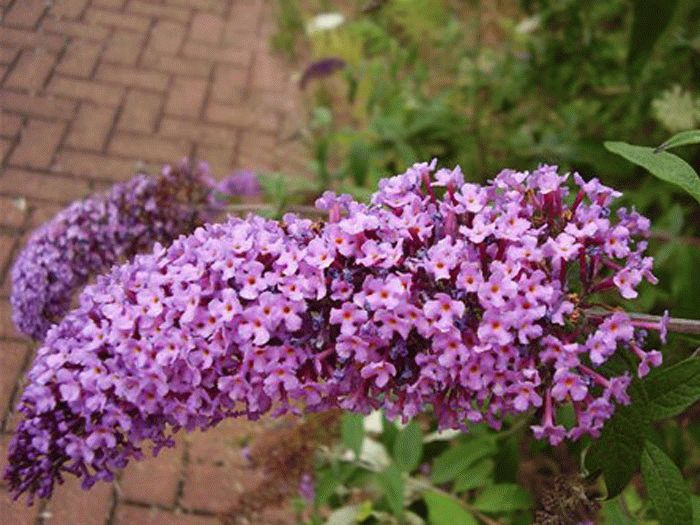

Blooming budley in the garden
Pruning buddley
It is necessary to improve the appearance of the bush by cutting off faded inflorescences. Rusty branches should be removed. Pruning David's budley bush will give it the desired shape when used as a hedge.
Rate the article
Please rate the article
Total voted 5. Rating 4,20 out of 5
Legend associated with the Lilac
According to ancient Greek legend, a young god of forests and meadows named Pan met the river nymph Syringa, who is considered the messenger of the morning dawn. He so admired the beauty of the young nymph that he completely forgot about his amusements. Pan decided to speak to Siringa, but she got scared of him and ran away. Pan followed the trail to calm her down, to say that he would not harm her, but the nymph suddenly turned into a bush with fragrant delicate purple flowers. Pan went up to the bush, hugged him and began to cry. Since then, the young forest god has become sad and lonely. He walked through his domains, trying to do only good deeds. And the name of the nymph became the Latin name of the plant.
How to keep cut lilac fresh: tips
How to keep freshly cut lilacs in a vase for a long time, planting and caring for which at the exit resulted in a chic, beautifully formed bouquet? To do this, you need to know a few subtleties of such a delicate operation.
You need to cut it in the early morning, while removing most of the leaves from the branches, because they evaporate a lot of moisture. Cut lilacs last longer from young bushes than from old ones. In the inflorescence there should be at least 2/3 of the opened flowers, because the buds will no longer bloom in the cut. Before placing a bouquet in a vase, you need to refresh the oblique cuts by making new ones under water. A tricky but effective technique: crush the ends of the shoots with a hammer. It is recommended to add 2-3 grams of acetic or citric acid to the water. A withered bouquet can be freshened up by placing it in very hot water.


